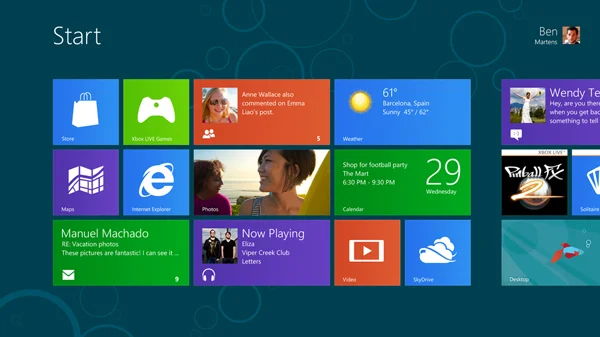Windows 8 is different than other iterations of this product. Rather than refining an old product Microsoft has remade the OS for a broad range of touch screen devices as well as laptop and desktop boxes. This new strategy is a game changer for the industry. And it isn't just Microsoft that is riding on the success of this product; it is hardware manufactures as well. The new interface is strikingly different than that of any other operating system out there. The start screen is comprised of panels which allow easier access to data, applications, and allow for a greater level of customization than previously possible on Microsoft, Apple, or other operating system start screens. The visual design elements from the preview are notable and represent a leap forward in design for the field in general. The new touch controls allow for considerably easier control in fewer hand motions. Menus and applications now can be access from the right, left and bottom of the screen and can be customized.
Additionally, this is the first operating system that fully integrates cloud computing and as such is likely to enable growth of cloud computing solutions in general. The cloud computing model could potentially save money for arts organization through the elimination of storage maintenance and upgrades. Cloud storage, of course, has a downside, namely that disconnection from the internet means your files and applications are knocked off line as well.
Into the nuts and bolts of things, Microsoft made this operating system more streamlined than previous versions of Windows making it considerable faster and mobile device friendly. Combined with the new MS tablet, Surface, it is easy to see where this is going. Mousing features through touch screen interfaces have been made more intelligent. Commands have been made easier to execute with average manual dexterity and features have been put in place that make it hard to send false commands.
On the Surface side of things writing a review becomes a bit more difficult. The product unveiling party has only been the first look at the product and demo models are not readily available to the public. This product is made to run the new Windows 8 OS and as such represents a shift in Microsofts thinking, from making software that will run on some other company's hardware to making their own software.
This strategy has worked for them before with the launch of the X-Box gaming platform but it failed for Microsoft with their Zune product which was recently canned. The design of the Surface looks more like a UltraBook or a slimmed down (even compared with Apple's Air notebook computer) but incorporates touchscreen. If it works well it will likely draw people who have gone to the I-Pad but are frustrated with the limited ability to, well, type and get work done. It should make significant inroads into the business traveler market which is always looking for a lighter product to get work done on.
In an arts setting these products both have tremendous potential (again if Microsoft doesn't screw it up) to appeal to the creative class. The use of color and the literally hands on approach that Microsoft is now taking towards this next generation of products may make computing easier for many who prefer user friendliness over the ability to get under the hood and twiddle with things.

